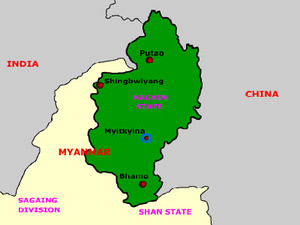What is the issue?
- India has largely been appreciable in terms of settling land and maritime boundaries in its neighbourhood.
- But the differences between Myanmar and Bangladesh demands India's attention and cooperation with other regional powers, given China's role.
How are India's maritime boundaries?
- One of India’s remarkable diplomatic achievements has been that it has settled its maritime boundaries with all its eastern neighbours.
- Bilateral agreements on maritime boundaries with Bangladesh, Sri Lanka, Myanmar, Thailand and Indonesia have contributed to this.
- But besides this, tripartite agreements have been made to determine tri-junctions.
- These include agreements with Myanmar and Thailand, Indonesia and Thailand and with Sri Lanka and Maldives.
- Even arriving at an agreement to demarcate maritime frontiers with Pakistan will not be difficult, once the land boundaries are demarcated.
- In any case, there have rarely been any maritime tensions with Pakistan.
How does it compare with China?
- Delineating maritime boundaries in accordance with international law give India the reputation of being a responsible power, across its eastern neighbourhood.
- In contrast, China has maritime boundary disputes with Japan, South Korea, Taiwan, Vietnam, the Philippines, Brunei, Malaysia and Indonesia.
- India readily implemented a verdict by an International Tribunal, which went against its claims on its maritime boundary with Bangladesh.
- China has, however, violated the UN Convention on the Law of the Sea by rejecting a similar decision, on its maritime boundary with the Philippines.
- Beijing has also used military intimidation to enforce its maritime claims on countries like the Philippines and Vietnam.
What is the case with Bangladesh and Myanmar?
- Another important factor in dealing with eastern neighbours has been the development of cooperation across land borders.
- India has settled land borders with both Myanmar and Bangladesh.
- It has moved forward in strengthening trade, investment and connectivity cooperation with them.
- Both Bangladesh and Myanmar have been helpful and cooperative in dealing with Indian separatist groups, which seek to operate from their soil.
- Prospects for cooperation have been augmented, as Bangladesh and Myanmar welcome increasing regional cooperation in BIMSTEC.
What is the refugee issue?
- Myanmar Army made a crackdown on Muslim Rohingyas in Myanmar’s Rakhine Province.
- This has led to over 7,00,000 Muslim Rohingya refugees from Myanmar fleeing to, and imposing a huge economic burden, on Bangladesh.
- To make matters worse, the repatriation of refugees is becoming harder than expected.
- There are prolonged negotiations and promises of aid for refugee resettlement from India, China and Japan.
- But there are just not adequate facilities for the displaced and traumatised refugees to return.
- With this, relations between Bangladesh and Myanmar have worsened.
- Myanmar alleges that Rohingya refugees are being armed in Bangladesh, amidst denials by Bangladesh.
What is China's role here?
- With growing international pressures because of its alleged persecution of Rohingyas, Myanmar is turning increasingly to China for support.
- Taking advantage of this, China is interfering in Myanmar’s internal affairs, for working out a political settlement with the trans-border armed, ethnic groups.
- China is also demanding Myanmar’s consent to go ahead with the massive Myitsone Dam hydroelectric project.
- The Myitsone Dam’s construction has been strongly opposed by the people of Kachin State.
- Given its location, the electricity produced by this project will be largely consumed in China’s Yunnan Province.
- It has also been controversial in Myanmar, with environmental impact on its huge flooding area and its location, barely 60 miles from the earthquake prone Sagaing faultline.
- But China keeps professing that it promotes contacts between the Myanmar government and armed insurgent groups, operating across the China-Myanmar border.
- The most powerful of these groups, the United Wa State Army (UWSA), operates from China, across the Shan State, in western Myanmar.

Why is India concerned?
- India is concerned as UWSA is now allied to a “Northern Alliance,” comprising armed groups linked to the Kachin Independence Army (KIA).
- The KIA operates from the Kachin State, bordering Arunachal Pradesh.
- It has links with the Rohingya-dominated Arakan Rohingya Solidarity Army in Myanmar’s Rakhine State, bordering India.
- Moreover, National Socialist Council of Nagaland (NSCN-K) members, involved in armed insurgency in Manipur and Nagaland, routinely move across the Myanmar-China border.
- Growing Chinese influence in Kachin State, which borders Arunachal Pradesh, undermines Myanmar’s sovereignty.
- It also adversely affects India’s security interests.
What lies ahead?
- Japan, like India, appears to recognise the dangers of pushing Myanmar to a corner, on the Rohingya issue.
- Because, this will make Myanmar even more dependent on Chinese support in the UN.
- The focus of attention of the international community should be on rehabilitation of refugees.
- Both India and Japan should work jointly, in both Myanmar and Bangladesh, to amicably settle the problem of repatriation and resettlement of refugees.
- The SAARC is now non-functional; BIMSTEC is, however, showing promise, complementing connectivity and trade.
- Differences and tensions between Myanmar and Bangladesh should not be allowed to worsen, as it will undermine India's efforts to promote regional cooperation in eastern neighbourhood.
Source: BusinessLine
